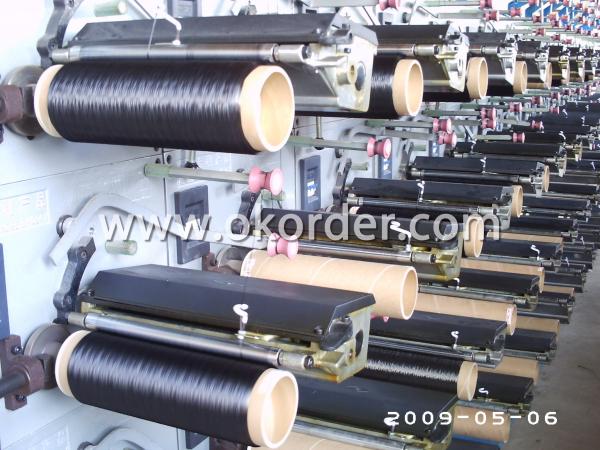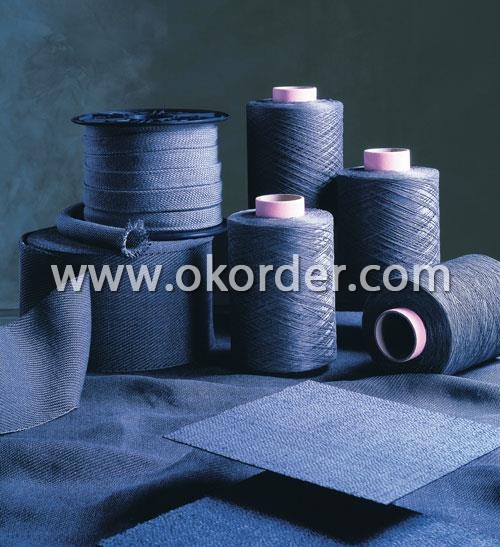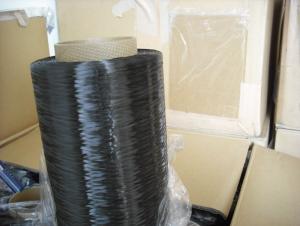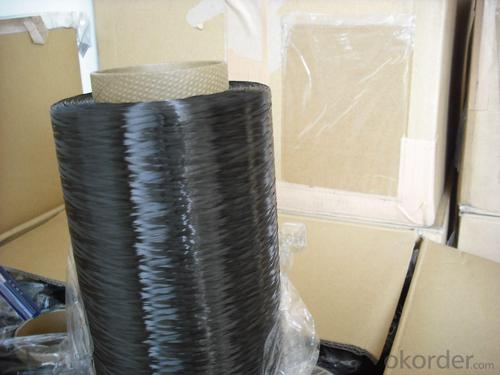Carbon Fiber 6K-1200TEX
- Loading Port:
- China Main Port
- Payment Terms:
- TT or LC
- Min Order Qty:
- 2Ton m.t.
- Supply Capability:
- 1000Ton m.t./month
OKorder Service Pledge
OKorder Financial Service
You Might Also Like
Specifications of Carbon Fiber 6K-1200TEX
1. Material: carbonized polyacrylonitrile fiber
2. Filament number:3k
3. Fiber type: T700
4. Tensile strength: 360kgf/mm2
General Data of Carbon Fiber Fabric
|
Tow Size |
Tow Count/CM |
Weave Style |
WidthRange (mm) |
Std. Width (mm) |
Thickness (mm) |
FAW (g/sq.m) |
FAW (oz/sq.yd) |
|
3K |
4 x 4 |
Plain |
10~1500 |
1000 |
0.16 |
160 |
4.72 |
|
3K |
4 x 4 |
2x2 Twill |
10~1500 |
1000 |
0.16 |
160 |
4.72 |
|
3K |
5 x 4 |
Plain |
10~1500 |
1000 |
0.18 |
180 |
5.31 |
|
3K |
5 x 4 |
2x2 Twill |
10~1500 |
1000 |
0.18 |
180 |
5.31 |
|
3K |
5 x 5 |
Plain |
10~1500 |
1000 |
0.2 |
200 |
5.90 |
|
3K |
5 x 5 |
2x2 Twill |
10~1500 |
1000 |
0.2 |
200 |
5.90 |
|
3K |
5 x 6 |
Plain |
10~1500 |
1000 |
0.22 |
220 |
6.49 |
|
3K |
5 x 6 |
2x2 Twill |
10~1500 |
1000 |
0.22 |
220 |
6.49 |
|
3K |
6 x 6 |
Plain |
10~1500 |
1000 |
0.24 |
240 |
7.08 |
|
3K |
6 x 6 |
2x2 Twill |
10~1500 |
1000 |
0.24 |
240 |
7.08 |
|
3K |
8 x 8 |
Plain |
10~1500 |
1000 |
0.32 |
320 |
9.44 |
|
3K |
8 x 8 |
2x2 Twill |
10~1500 |
1000 |
0.32 |
320 |
9.44 |
|
3K |
8 x 8 |
8H Satin |
10~1500 |
1000 |
0.32 |
320 |
9.44 |
Storage of Carbon Fiber 6K-1200TEX
It is recommended that the carbon fiber fabric are stored in a cool and dry environment. Recommended temperature range of storage is between 10 ~ 30 degree and relative humidity between 50 ~ 75%.The carbon fiber fabric should remain in the packaging until just prior to use.
Packaging & Delivery of Carbon Fiber 6K-1200TEX
Product is manufactured in form of a roll wound on a paper tube and then packed in a plastic film and placed within a cardboard carton. Rolls can be loaded into a container directly or on pallets.
Packaging Detail: carton
Delivery Detail: within 20 days


- Q: What is the density of carbon?
- Carbon's density varies depending on its form. Graphite, the most prevalent form of carbon, has a density of 2.267 g/cm³. In contrast, diamond, another form of carbon, boasts a significantly higher density of 3.515 g/cm³. Therefore, it is crucial to specify the form of carbon being discussed when referring to its density.
- Q: How does carbon occur in nature?
- Carbon occurs in nature in various forms and is one of the most abundant elements on Earth. It is found in the atmosphere, in the Earth's crust, and in living organisms. In the atmosphere, carbon exists primarily as carbon dioxide (CO2), which is produced through natural processes such as respiration, volcanic activity, and the decay of organic matter. This CO2 is then absorbed by plants during photosynthesis to produce energy and release oxygen. Carbon is also present in other greenhouse gases like methane (CH4), which is produced by natural processes such as the decomposition of organic matter in wetlands and the digestive processes of certain animals. In the Earth's crust, carbon is found in various minerals such as limestone, dolomite, and graphite. These minerals are formed through the deposition and accumulation of marine organisms, such as shells and skeletons of marine organisms, over millions of years. Carbon is also a key component of fossil fuels, including coal, oil, and natural gas, which are formed from the remains of ancient plants and animals buried and subjected to high pressure and temperature over time. Furthermore, carbon is an essential element for all living organisms and is the basis of organic chemistry. It is the key component of all organic matter, including carbohydrates, proteins, lipids, and nucleic acids, which form the building blocks of life. Carbon cycles through various biological processes, such as photosynthesis, respiration, and decomposition, allowing it to be continually recycled within ecosystems. Overall, carbon occurs naturally in the environment in different forms and plays a crucial role in the Earth's climate system, geological processes, and the sustenance of life.
- Q: Joint carbide gas incident
- After a lapse of 25 years, a India District Court on 1984 Bhopal gas leak to be long in coming judgment, Union Carbide (India) Co., Ltd. 7 India nationals day was held for negligence causing death, they will face up to two years in prison. On the same day, hundreds of survivors, family members and environmentalists gathered around the courthouse to protest the court's decision that the perpetrators of the worst industrial disaster in twentieth Century were too light and too late. In 1969, Union Carbine Co established a Union Carbide in central India state of Bhopal Beijiao city (India) Co. Ltd., specializing in the production of aldicarb, carbaryl pesticide drops. The chemicals used in these products is called a methyl isocyanate poisonous gas. The early morning of December 3, 1984, this factory storage explosive liquid methyl isocyanate the steel tank, 45 tons of poison gas leak quickly, directly killed more than 1.5 people, allegedly have caused more than 550 thousand people died and chemical poisoning related lung cancer, renal failure and liver disease.
- Q: What is carbon sequestration?
- The process of carbon sequestration involves capturing carbon dioxide (CO2) from the atmosphere and storing it for a long time, preventing its release and its contribution to climate change. The objective is to decrease the concentration of CO2 in the atmosphere, as this gas is a major cause of global warming. Carbon sequestration can happen naturally through biological processes like photosynthesis in plants and algae, or it can be done through various artificial methods. When plants, trees, and other vegetation absorb CO2 during photosynthesis and store it in their tissues, it is known as natural carbon sequestration. This is crucial in reducing CO2 levels in the atmosphere. Additionally, oceans also play a significant role in absorbing and storing large amounts of CO2, known as oceanic sequestration. Artificial carbon sequestration techniques involve capturing CO2 emissions from industrial processes, power plants, and other sources before they are released into the atmosphere. There are different methods for carbon capture, including capturing before combustion, after combustion, and through oxy-fuel combustion. Once the CO2 is captured, it can be transported and stored underground in geological formations like depleted oil and gas fields or saline aquifers. This process is commonly referred to as carbon capture and storage (CCS) or carbon capture utilization and storage (CCUS). Carbon sequestration has gained significant attention because of its potential to address climate change. By reducing the amount of CO2 in the atmosphere, it helps slow down global warming and mitigate the impacts of climate change. It is considered an essential part of the broader strategy to achieve net-zero emissions, as it not only reduces future emissions but also removes CO2 that has already been emitted. However, carbon sequestration is not a complete solution to climate change. It should be seen as a complementary approach to other mitigation efforts, such as transitioning to renewable energy sources and improving energy efficiency. Additionally, the long-term storage of CO2 requires careful monitoring and management to ensure its effectiveness and prevent any leakage or environmental risks. In conclusion, carbon sequestration is a crucial tool in the fight against climate change, offering the potential to reduce greenhouse gas emissions and contribute to a more sustainable future.
- Q: How is carbon used in the production of nanoelectronics?
- The production of nanoelectronics involves the diverse utilization of carbon. One of the most notable applications is seen in the creation of carbon nanotubes (CNTs), which are cylindrical structures composed solely of carbon atoms. These nanotubes possess exceptional electrical and mechanical properties that render them highly suitable for incorporation into nanoelectronic devices. CNTs can serve as transistors, which serve as the fundamental building blocks of electronic circuits. Due to their diminutive size and outstanding electrical conductivity, CNT transistors have the capacity to generate high-performance, low-power devices. Consequently, they hold the potential to supplant conventional silicon transistors, thus enabling the development of more sophisticated and compact electronic devices. In addition, carbon plays a pivotal role in the production of graphene, a single layer of carbon atoms arranged in a two-dimensional honeycomb lattice. Graphene exhibits extraordinary electrical conductivity, thermal conductivity, and mechanical strength. Consequently, it can function as a conductive material in nanoelectronics, thereby facilitating the creation of swifter and more efficient electronic devices. Moreover, carbon-based materials can be employed in nanoelectronics for energy storage purposes. For example, carbon nanotubes and graphene can be harnessed in supercapacitors, energy storage devices that possess the ability to rapidly store and discharge substantial amounts of electrical energy. These carbon-based energy storage systems hold the potential to revolutionize the realm of portable electronics and electric vehicles. In conclusion, the extensive utilization of carbon in the production of nanoelectronics can be observed. Its distinctive properties, including heightened electrical conductivity, mechanical strength, and thermal conductivity, render it an ideal material for the advancement of high-performance electronic devices. Carbon nanotubes, graphene, and other carbon-based materials serve as crucial components in the fabrication of nanoelectronic devices, thereby enabling progress in computing power, energy storage, and the miniaturization of electronic components.
- Q: Organic matter is converted from organic carbon. Why is humus represented by carbon instead of converted?
- Therefore, only there is a certain relationship between soil carbon content and soil organic matter, high carbon content of soil humus certain, but it does not explain the soil organic matter, because organic matter contains not only the humus, also contains many other organic substances are not decomposed.
- Q: What are the effects of carbon emissions on the stability of urban infrastructure?
- Urban infrastructure stability is significantly impacted by carbon emissions. The atmosphere is polluted with carbon dioxide and other greenhouse gases from different sources like industrial activities, transportation, and energy production, resulting in climate change. This, in turn, poses numerous challenges to urban infrastructure. Among the primary effects of carbon emissions on urban infrastructure stability is the increased frequency and severity of extreme weather events. Climate change leads to more intense heatwaves, storms, hurricanes, and flooding, causing substantial damage to buildings, roads, bridges, and other infrastructure components. Higher temperatures also cause materials to expand and contract, resulting in structural issues and reduced durability. Additionally, rising sea levels caused by carbon emissions contribute to the melting of polar ice caps, putting coastal cities at risk of flooding and erosion. This threatens critical infrastructure in these areas, such as ports, water treatment facilities, and transportation systems. The stability of urban infrastructure is compromised as sea levels continue to rise. Carbon emissions also impact energy supply and demand, affecting urban infrastructure stability. Climate change leads to extreme weather events that disrupt power grids and energy infrastructure, resulting in blackouts and service disruptions. Moreover, the increased demand for cooling systems due to rising temperatures can strain existing infrastructure and overload the electrical grid. Furthermore, carbon emissions contribute to air pollution, which negatively affects the health and well-being of urban populations. Poor air quality leads to respiratory and cardiovascular diseases, impacting the workforce and productivity. This indirectly affects the stability of urban infrastructure, as a healthy and productive population is crucial for the functioning of cities. To mitigate the effects of carbon emissions on urban infrastructure stability, various measures can be implemented. These include transitioning to renewable energy sources, improving energy efficiency in buildings and transportation, implementing sustainable urban planning strategies, and investing in climate-resilient infrastructure. These actions can reduce carbon emissions and build infrastructure capable of withstanding the challenges posed by climate change, ultimately ensuring the stability and resilience of urban areas.
- Q: I saw a cell phone in the magazine, the global release of 900, no camera, what function is F1 carbon fiber material, actually sold 40000 yuan a piece!.. Everyone said that the circulation is so small, worth so much money? Or carbon fiber material worth so much money?
- In fact, whether carbon fiber or 900 are gimmicks, he is in the advertising of this mobile phone to deceive people
- Q: What are the advantages of carbon-based fuel cells?
- There are several advantages of carbon-based fuel cells. Firstly, carbon-based fuel cells, such as those using hydrogen or methanol, have a high energy density, allowing for longer operating times and greater efficiency. Secondly, carbon-based fuel cells are environmentally friendly as they produce fewer emissions compared to traditional fossil fuel combustion. Additionally, carbon-based fuel cells are versatile and can be used in a variety of applications, from powering vehicles to providing electricity for homes and businesses. Finally, carbon-based fuel cells offer a promising alternative to traditional energy sources, reducing our dependence on finite resources and contributing to a more sustainable future.
- Q: How is carbon used in the production of construction materials?
- Carbon is used in the production of construction materials through a process called carbonization, where organic materials such as wood, coconut shells, or coal are heated to high temperatures in the absence of oxygen. This results in the removal of other elements and the production of carbon-rich materials like activated carbon or charcoal, which can be used in various construction applications such as concrete production, filtration systems, or as a component in composite materials.
1. Manufacturer Overview
| Location | Shanghai, China |
| Year Established | 1995 |
| Annual Output Value | Above US$ 20,000 |
| Main Markets | Mid East; Eastern Europe; North America |
| Company Certifications | ISO 9002:2000 |
2. Manufacturer Certificates
| a) Certification Name | |
| Range | |
| Reference | |
| Validity Period |
3. Manufacturer Capability
| a) Trade Capacity | |
| Nearest Port | Shanghai |
| Export Percentage | 20% |
| No.of Employees in Trade Department | 100 People |
| Language Spoken: | Chinese |
| b) Factory Information | |
| Factory Size: | Above 100,000 square meters |
| No. of Production Lines | Above 5 |
| Contract Manufacturing | OEM Service Offered; Design Service Offered |
| Product Price Range | Average |
Send your message to us
Carbon Fiber 6K-1200TEX
- Loading Port:
- China Main Port
- Payment Terms:
- TT or LC
- Min Order Qty:
- 2Ton m.t.
- Supply Capability:
- 1000Ton m.t./month
OKorder Service Pledge
OKorder Financial Service
Similar products
Hot products
Hot Searches
Related keywords



























